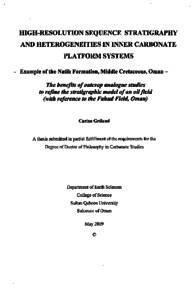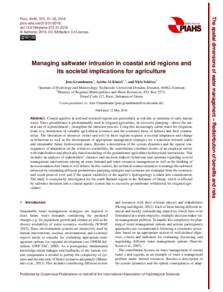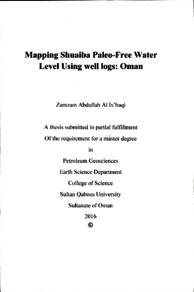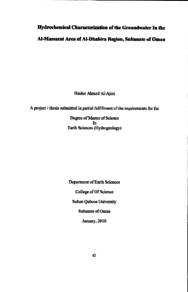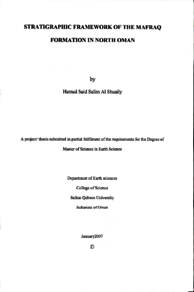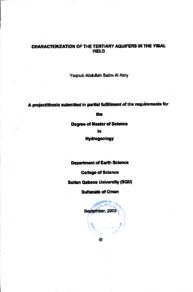Document
Hydrogeological characterisation of the tertiary formations in the Yibal field, north Oman
Publisher
Sultan Qaboos University
Gregorian
2003
Language
English
Subject
English abstract
Yibal field is one of the most important fields to Petroleum Development Oman (PDO). At a certain time, the field used to produce one quarter of PDO's total production. The principal hydrocarbon reservoir is Shuaiba (ca. 1300 meter below sea level). Drilling into the reservoir is preceded by drilling the Tertiary Formations that consist of the Umm er Radhuma (UeR) Formation, Rus Formation, Dammam Formation and Fars group. The Fars and the upper UeR are aquifers whereas the rest may be considered as aquitards. Usually those Formations are associated with lots of problems that include losses, inefficient cement jobs, casing corrosion, water flowouts and blowouts that in some incidents had caused the loss of the whole drilling rig. The field contains 474 wells where some of them are 30 years old. Older wells are more apt to the well integrity problems mentioned before. The most recent water flowouts are the Y-86 and Y-177, which happened while writing this study. Th concern to thoroughly understand the geometry of those formations. Until now limited information is known about the hydrogeological characterisation of the Yibal overburden Formations.
This study aims at characterising the Yibal Tertiary Formations both from geological and hydrological perspectives. This forms the base to building a conceptual model where this study deals with the static part of it. The model could be used to test for the conditions that would permit communication between the Fars and UeR
It could also be used for monitoring any contaminant in the future. The dynamic part of the model is going to be built in a separate project.
Data for the study mainly comes from seismic data, data of 417 wells and aquifer test data. From the seismic data that was acquired in 1993, various illumination plots have been constructed to make an interpretation of the shallow subsurface faults.
Following an extensive quality checking of the Formation tops data using gamma ray logs, top structure maps of the various Formations have been constructed.
Aquifer tests data of the Umm er Radhuma and Fars aquifers have been used to establish the transmissivity and hydraulic conductivity.
Bringing all the results together ended up with building a 14-layers model with average matrix properties.
Inadequate quality of aquifer test data and lack of basic geological data (e.g. Core data) are the sources of deviation from proper characterisation of the Tertiary system and hence building a more realistic 3-D flow model.
Arabic abstract
يعد حفل يبال واحدا من أهم الحقول النفطية لشركة تنمية نفط عمان (PD0 )، في وقت من الأوقات ، كان إنتاج الحفل قد بلغ ما يقارب ربع الإنتاج الإجمالي للشركة , تمثل طبقة شعيبة ( تحت عمق 1300 م تحت مستوى سطح البحر) مخزون النفط الرئيس للحقل. الحفر إلى المخزون مسبوق بحفر تشكيلات العصر الثلاثي التي تتضمن تشكيل ام لرضمة وتشكيل الرس وتشكيل الحمام ومجموعة فارس ، تعد فارس و الطبقة العلوية لام الرضمة طبقات مياه جوفية بينما تعتبر البقية موانع السريان المياة الجوفية عادة ما تصاحب عملية حفر التشكيلات العديد من المشاكل والتي تتضمن فقدان طين الحفر ، عملیات اسمنت غير جيدة ، تاكل غلاف الحفر ، صعود المياه الجوفية وانفجارات متعددة والتي في بعض الأحيان سببت خسارة منصة الحفر باكملها. يحتوي الحفل على 474 بئر والتي يبلغ عمر بعضها ثلاثين عاما . هذا وتعد الآبار الأقدم اكثر
عرضة للمشاكل السابقة الذكر وكان اقرب حوادث صعود المياة الحوادث التي حصلت في بنري ببال -86 ويبل-177 والتي حدثت ايان عمل هذة الدراسة كل هذا يثير القلق والتساؤل لفهم هندسة تلك التشكيلات فهما عميقا ، وإلى الآن المعرفة المتوفرة عن التشكيلات السطحية من الناحية الهيدروجيولوجية لا تتعدى ان تكون معلومات محدودة
تستهدف هذة الدراسية لتشخيص تشكيلات العصر الثلاثي في منطتة يبال من الناحيتين الجيولوجية والهيدرولجية مما يمثل قاعدة لبناء نموذج تصوري حيث تتعامل هذة الدراسية مع الجزء الساكن منه من الممكن أن يستعمل النموذج لإختبار الحالات التي تسمح بالإتصال المباشر ما بين طبقتي فارس ولم الرضمة . ويمكن أن يستخدم مستقبلا لمراقبة التلوث مما يجدر بالذكر أن النموذج المتحرك ز الدينامي) سيبني في مشروع منفصل . المصدر الرئيسي لبيانات هذة الدراسة ياتي من البيانات الزلزالية ، بيانات متنوعة عن 417 بنر وبيانات فحص الطبقة الجوفية ، بعد معالجة البيانات الزلزالية التي أخذت في عام 1993 عن طريق إنشاء مكعبات إضاءة كان من الممكن تفسير التصدعات الضحلة بعد فحص شامل لبيانات أعماق التشكيلات بإستخدام سجلات شعاع جاما كان من الممكن بناء خرائط أعماق التشكيلات المختلفة بیانات فحص الطبقات الجوفية لكل من ام الرضمة وفارس استخدمت لتاسيس نفانية ودرجة التوصيل الهيدروليكي لهذة الطبقات ضم كل هذة النتائج معا نتج عنه بناء نموذج تصوري يحتوي على 14 طبقة ذات خواص متوسطة الجودة المتدنية لبيانات فحص الطبقة الجوف من الجيولوجية الأساسية (مثال :- بيانات التطاع الطولى ) ادى إلى الحيلولة دون التمكن من الوصف الدقيق لطبقات العصر الثلاثي وبالتالي إلى عدم إمكانية بناء نموذج تدفق مائي ذو ابعاد ثلاثية
من الطبقة الجوفية وقلة البيانات الجيولوجيه.
عرضة للمشاكل السابقة الذكر وكان اقرب حوادث صعود المياة الحوادث التي حصلت في بنري ببال -86 ويبل-177 والتي حدثت ايان عمل هذة الدراسة كل هذا يثير القلق والتساؤل لفهم هندسة تلك التشكيلات فهما عميقا ، وإلى الآن المعرفة المتوفرة عن التشكيلات السطحية من الناحية الهيدروجيولوجية لا تتعدى ان تكون معلومات محدودة
تستهدف هذة الدراسية لتشخيص تشكيلات العصر الثلاثي في منطتة يبال من الناحيتين الجيولوجية والهيدرولجية مما يمثل قاعدة لبناء نموذج تصوري حيث تتعامل هذة الدراسية مع الجزء الساكن منه من الممكن أن يستعمل النموذج لإختبار الحالات التي تسمح بالإتصال المباشر ما بين طبقتي فارس ولم الرضمة . ويمكن أن يستخدم مستقبلا لمراقبة التلوث مما يجدر بالذكر أن النموذج المتحرك ز الدينامي) سيبني في مشروع منفصل . المصدر الرئيسي لبيانات هذة الدراسة ياتي من البيانات الزلزالية ، بيانات متنوعة عن 417 بنر وبيانات فحص الطبقة الجوفية ، بعد معالجة البيانات الزلزالية التي أخذت في عام 1993 عن طريق إنشاء مكعبات إضاءة كان من الممكن تفسير التصدعات الضحلة بعد فحص شامل لبيانات أعماق التشكيلات بإستخدام سجلات شعاع جاما كان من الممكن بناء خرائط أعماق التشكيلات المختلفة بیانات فحص الطبقات الجوفية لكل من ام الرضمة وفارس استخدمت لتاسيس نفانية ودرجة التوصيل الهيدروليكي لهذة الطبقات ضم كل هذة النتائج معا نتج عنه بناء نموذج تصوري يحتوي على 14 طبقة ذات خواص متوسطة الجودة المتدنية لبيانات فحص الطبقة الجوف من الجيولوجية الأساسية (مثال :- بيانات التطاع الطولى ) ادى إلى الحيلولة دون التمكن من الوصف الدقيق لطبقات العصر الثلاثي وبالتالي إلى عدم إمكانية بناء نموذج تدفق مائي ذو ابعاد ثلاثية
من الطبقة الجوفية وقلة البيانات الجيولوجيه.
Member of
Resource URL
Same Subject
